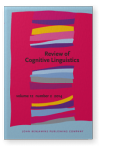Theoretical and computational considerations of linking constructions in Role and Reference Grammar
Brian Nolan | Institute of Technology Blanchardstown Dublin, Ireland
This paper proposes a view of the linguistic construction in Role and Reference Grammar (RRG) in which constructions are posited to be structured grammatical objects with a unique constructional signature that uniquely identifies them. We argue that the construction has an input and an output, and that it contains a local workspace in which the processing of the various lexical and grammatical rules applies, according to the constraints within the constructional object. In recent years there has been a growing recognition that the RRG account of constructions is an under-utilised resource that deserves a wider application to problems in cross-linguistic analysis (Nolan & Diedrichsen, 2013; Nolan & Periñán, 2014). As a functional grammar with strong claims of adequacy, RRG has however had several challenges from Construction Grammar (Butler & Martín Arista, 2009; Goldberg, 2006; Michaelis, 2006, 2010). This paper addresses a number of these challenges. In the view of constructions presented here, the linking over the syntactic, semantic and pragmatic interfaces resides in the body of the construction, and the construction interacts with the lexicon which provides lexical information relevant to the construction. The constructions reside in a construction repository. This model of constructions delivers a means to address the challenges posed to the RRG account of the role and place of constructions within a lexicalist functionalist model of grammar.
References
Boas, H., & Sag, I
(
2013)
Sign-based construction grammar. Stanford: CSLI.

Butler, C.S
(
2009)
Criteria of adequacy in functional linguistics.
Folia Linguistica, 43 (1), 1–66.


Butler, C.S., & Martín Arista, J
Croft, W
(
2001)
Radical construction grammar: Syntactic theory in typological perspective.
Oxford: Oxford University Press.


Fillmore, C.J., Kay, P., & O’Connor, M.C
(
1988)
Regularity and idiomaticity in grammatical constructions: The case of let alone
.
Language, 641, 501–538.


Fried, M., & Östman, J.-O
Goldberg, A
(
1995)
Constructions: A construction grammar approach to argument structure. Chicago: University of Chicago Press.

Goldberg, A
(
2006)
Constructions at work: The nature of generalization in language. Oxford: Oxford University Press.

Jiménez-Briones, R., & Luzondo-Oyón, A
Kay, P., & Fillmore, C.J
(
1999)
Grammatical constructions and linguistic generalizations: The What’s X doing Y? construction.
Language, 75 (1), 1–33.


Michaelis, L.A
(
2006)
Construction grammar. In
K. Brown (Ed.),
The encyclopaedia of language and linguistics, 2nd edition, Volume 31 (pp. 73–84). Oxford: Elsevier.


Michaelis, L.A
(
2010)
Sign-based construction grammar. In
B. Heine &
H. Narrog (Eds.),
The Oxford handbook of linguistic analysis (pp. 139–158). Oxford: Oxford University Press.

Michaelis, L.A., & Lambrecht, K
(
1996)
Towards a construction-based theory of language function: The case of nominal extraposition.
Language, 721, 215–247.


Nolan, B
(
2010a)
The layered structure of the Modern Irish word: An RRG account of derivational morphology based on lexeme constructional schemata. In
W. Nakamura (Ed.),
Proceedings of the 10th International Conference on Role and Reference Grammar 2009
.
[URL] Available at May 2014.
Nolan, B
(
2010b)
Constructional polysemy and argument realisation with the Irish GET verb. Workshop on ‘Variation and Change in Argument Realization.’ University of Naples in Capri and Naples, Italy.
Nolan, B
(
2010c)
The GET construction of Modern Irish and Hiberno-English: Passive and recipient variations. Paper presented at: ‘Construction Grammar: New perspectives for the study of German and English’ – International Conference at the Christian-Albrecht University Kiel, Germany.
Nolan, B
(
2012a)
Constructional polysemy and argument realisation with the Irish GET verb. In
A.N. Lenz &
G. Rawoens (Eds.),
The art of getting: GET verbs in European languages from a synchronic and diachronic point of view. Special Issue of
Linguistics, 50 (6), 1111–1162.

Nolan, B
(
2012b)
The syntax of Irish: A functional account. Sheffield: Equinox.

Nolan, B
(
2013c)
Modelling speech acts through conversational agents in a functional model of grammar. Paper presented at the 31st AESLA Conference “Communication, Cognition, Cybernetics”. University of La Laguna 18th–20th April, 2013, in Tenerife, Spain.
Nolan, B
(
2013d)
Extending a lexicalist functional grammar through speech acts, constructions and conversational software agents. Plenary talk presented at the 2nd International Conference on Meaning and Knowledge Representation in LCM and FunGramKB. Facultad de Ciencias Económicas y Empresariales de Granada. Universidad de Granada, in Granada, Spain.
Nolan, B
(
2013e)
The encoding of negation in Modern Irish: Negation at the layered structure of the clause and noun phrase. Paper presented at the Role and Reference Grammar (RRG) conference at the Freiburg Institute of Advanced Studies (FRIAS), at the Albert-Ludwigs-Universitat Freiberg, Germany.
Nolan, B., & Diedrichsen, E
Ruiz de Mendoza, F. J., & Mairal, R
(
2008)
Levels of description and constraining factors in meaning construction: An introduction to the Lexical Constructional Model
.
Folia Linguistica, 42 (2), 355–400.

Van Valin, R.D
(
2005)
Exploring the syntax-semantics Interface. Cambridge: Cambridge University Press.


Veale, T
(
2006)
Computability as a test on linguistic theories. In
G. Kristiansen,
M. Achard,
R. Dirven &
F.J. Ruiz de Mendoza (Eds.),
Cognitive linguistics: Current applications and future perspectives (pp. 461–484). Berlin: Mouton de Gruyter.

Cited by
Cited by 1 other publications
Luzondo-Oyón, Alba & Francisco J. Ruiz de Mendoza-Ibáñez
2015.
Argument structure constructions in a Natural Language Processing environment.
Language Sciences 48
► pp. 70 ff.

This list is based on CrossRef data as of 13 april 2024. Please note that it may not be complete. Sources presented here have been supplied by the respective publishers.
Any errors therein should be reported to them.
